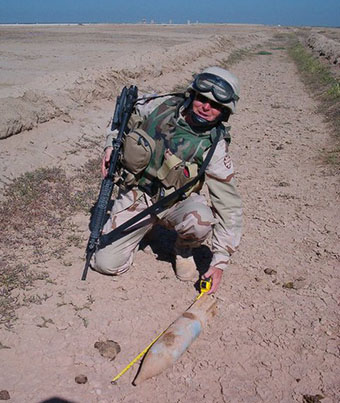Routine Physical Saves Veteran’s Life after Burn Pit Exposure

PACT Act Provides Care and Benefits for Warriors Impacted by Toxic Exposure
| Table of Contents | |
| Toxic Exposure and Cancer | |
| Majority of Post-9/11 Warriors Exposed to Burn Pits | |
| PACT Act Becomes Law | |
| Deadlines and Eligibility | |
| Protecting the Next Generation of Veterans |
Army veteran Andrew Myatt did all the right things to take care of himself. He exercised, ate well, didn’t smoke or drink. After more than 20 years in the service, he’d developed a routine and felt fit and healthy, but he still made sure to get his regular physicals. It turned out, that’s what saved his life.
During a routine physical, Andrew’s doctor saw something concerning and sent him to an oncologist for more tests. The result: an aggressive form of adult leukemia, a cancer that affects the blood-forming cells in the body. Because the cancer was caught early, Andrew immediately began chemotherapy and other treatments. After finishing three years of heavy rounds of chemo, Andrew’s leukemia was in remission, but his weakened immune system left him susceptible to other ailments – including skin cancer, which he’s currently being treated for.
“On paper, I did everything I was supposed to,” Andrew said. “I don't drink soda or eat fast food. I have a very healthy lifestyle and diet. And yet, I've come down with two cancers in the last three years.”
Initially, Andrew didn’t connect his cancer to his time in the military, including multiple deployments, or exposure to burn pits. In the early stages after his diagnosis, he just focused on getting treatment and beating the disease rather than thinking about how it happened.
It wasn’t until he spoke with a benefits expert from Wounded Warrior Project® (WWP) about his exposure to toxins that he started doing some research and made the correlation.
Toxic Exposure and Cancer

“It's amazing how much information is out there, which you don't even think to look for,” Andrew said. “This is something that's happening throughout the community of veterans, especially people who served in the Middle East.”
Another warrior, Scott Evans, publicly shared his story about his fight against cancer.
Scott did two tours in Afghanistan with the U.S. Marines, helping train military dogs to detect improvised explosive devices (IEDs). A lot of the training was done in and around burn pits. During his time in Afghanistan, Scott said he began to experience chronic coughing and sneezing, but attributed it to the dry, sandy desert climate.
In 2020, less than nine years after being honorably discharged from the Marines, Scott was diagnosed with inoperable pancreatic cancer. In the months prior to his diagnosis, Scott struggled to qualify for Department of Veterans Affairs (VA) health care benefits because it had been more than five years since his discharge. After discovering WWP, Scott was able to get help accessing health care through VA and have his cancer designated as service-connected, qualifying him for disability benefits.
Sadly, Scott passed away from pancreatic cancer in 2022 before he could see life-saving toxic exposure legislation become law.
Majority of Post-9/11 Warriors Exposed to Burn Pits

Unfortunately, Andrew and Scott’s stories aren’t particularly uncommon for service members, especially those who served in combat zones.
According to WWP’s 2022 Annual Warrior Survey, 80% of post-9/11 warriors deployed to Iraq and Afghanistan were exposed to burn pits, most of whom (83%) were exposed daily or weekly. Toxic exposure and burn pit symptoms reported by warriors included decreased ability to exercise, shortness of breath, chronic sinus infections, and cough.
Andrew said he wished he’d been aware of the dangers posed by burn pits during his time in service.
“I was a senior NCO [non-commissioned officer], and I eventually became an officer. I knew nothing about toxic exposure, and I commanded soldiers in combat,” Andrew said. “Everything we do in the military is about risk mitigation, and it wasn’t even on my radar. I've talked to a lot of still-serving officers who served under me, and I've relayed this information to them, and they're now relaying to their soldiers. So just the fact that as a community, we're actually becoming aware of this and talking about it is amazing.”
The PACT Act Becomes Law
The effect of toxic exposure on service members was officially recognized on Aug. 10, 2022, when President Joe Biden signed the SFC Health Robison Honoring Our PACT Act into law. The PACT Act guarantees care and benefits for veterans who suffer ill effects of exposure to burn pits and other toxic substances while serving our nation.
WWP and other veterans service organizations advocated diligently for years to get this groundbreaking legislation passed and help warriors across the country.
The PACT Act:
- Declares presumptive conditions tied to toxic exposure.
- Establishes 31 new VA health care facilities.
- Grants VA health enrollment eligibility to any veteran who deployed to certain areas of known exposure during service.
To see if you qualify based on location of service and for a list of presumptive conditions, click here.
For injured combat veterans exposed to burn pits, like Andrew, the PACT Act helps alleviate the burden of proof needed to make a service connection for VA benefits. Veterans who qualify under the PACT Act and are diagnosed with cancer have priority when it comes to VA health care and other benefits.

“What the bill does is open up the door for entitlement to health care, even if they don't yet have a service-connected condition,” said Tim Velasquez, WWP veterans benefits training specialist. “Those new possibilities for health care under this bill are incredible as far as the opportunities they open to veterans who may not have had that door open to them before.”
Fortunately, Andrew’s cancer is in remission and he’s in good health, but there’s always a concern the cancer can return. WWP’s Benefits Services team was able to help Andrew file for VA benefits and get his cancer service connected to toxic exposure.
While the benefits of the PACT Act weren’t readily available when Andrew was battling cancer, he worked alongside WWP to see the bill become law, aware of the protections and benefits it can provide fellow veterans and the service members who come after him.
“The passing of the PACT ACT was a significant event in my life as a military leader,” Andrew said. “I have been able to share the knowledge gained during the process of advocating for the PACT ACT with thousands of veterans who are employed in the programs I oversee for the U.S. government. This has led to more veterans than I can count to file claims with VA and seek medical treatments with either VA or their primary care physicians.”
Deadlines and Eligibility
Veterans who served in locations and during dates specified in the PACT Act are encouraged to apply for VA benefits. Veterans diagnosed with a presumptive condition who file for VA disability compensation before Aug. 9, 2023, may be eligible for retroactive pay dating to Aug. 10, 2022, when the PACT Act became law.
Eligible veterans who do not have a qualifying medical diagnosis or aren’t currently feeling ill should still file for VA health care benefits. Post-9/11 combat veterans who were discharged over 10 years ago and are not enrolled in VA health care have a deadline of Oct. 1, 2023, to take advantage of the open enrollment period. If they miss it, they could be subject to a phased-in enrollment period, based on their discharge from service.
WWP’s Benefits Services have VA-accredited representatives who can help veterans navigate the benefits process and file for disability compensation and VA health care at no cost to the veteran.
Protecting the Next Generations of Veterans
For Andrew, the realization of all the things he was exposed to in his many years of service and his numerous deployments allowed him to put his cancer diagnosis in context.
“There are a lot of things you'll find in the military that you're exposed to that you never even realized at the time,” he said. “We all did multiple rotations. Now we have a lot of people who have survived those exposures and are getting older, and those effects are showing up.”
It’s a lesson Andrew hopes the military will use to protect those who continue to serve our country and those who will serve in the future.
“Ever since there has been a military, there has been something that we learned after major engagements that we probably should have done better,” Andrew said. “We figured these things out, and then we pass that information along. And for my generation [of service members], it's the burn pits.”
|
PACT Act Adds 3 Cancers to Presumptive Conditions List The Department of Veterans Affairs (VA) has included three new cancers to the list of presumptive conditions outlined in the PACT Act. These cancers include:
Veterans who currently have or previously had one of the listed cancers at any time during military service or after separation may be entitled to disability compensation benefits dated back to Aug. 10, 2022, the date the PACT Act was signed into law. VA will review all claims from impacted veterans and survivors who previously filed and were denied for these three conditions on or after Aug. 10, 2022, to determine if benefits can now be granted. Veterans enrolled in VA health care can obtain cancer screening and treatment at VA. Wounded Warrior Project® (WWP) and other veterans service organizations are also pushing to add several blood cancers as a presumptive condition in the PACT Act. The cancers would include acute leukemias, chronic leukemias, and multiple myeloma outside the head and neck. WWP supports VA’s plan to conduct a scientific review to determine whether to include these cancers in the legislation. The PACT Act declares presumptive conditions tied to toxic exposure during military service. It guarantees care and benefits for veterans who suffer ill effects of exposure to burn pits and other toxic substances while serving our nation. WWP is also encouraging VA to review other conditions beyond cancers and respiratory illnesses that could be associated with toxic exposure during deployment. Find out more about WWP’s advocacy efforts and legislative priorities. |
Contact: — Paris Moulden, Public Relations, pmoulden@woundedwarriorproject.org, 904.570.7910
About Wounded Warrior Project
Since 2003, Wounded Warrior Project® (WWP) has been meeting the growing needs of warriors, their families, and caregivers — helping them achieve their highest ambition. Learn more.